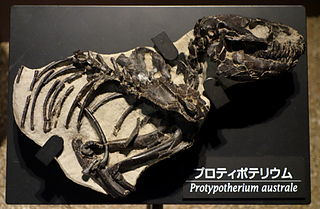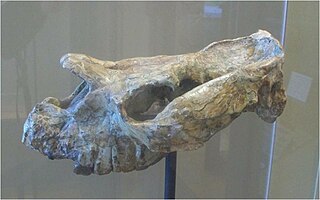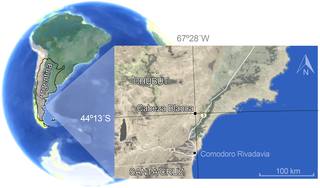The Deseadan (Spanish : Deseadense) age is a period of geologic time (29.0–21.0 Ma) within the Oligocene epoch of the Paleogene to the Early Miocene epoch of the Neogene, used more specifically within the SALMA classification of South America. It follows the Tinguirirican and precedes the Colhuehuapian age. [1]
The age is named after the Deseado Formation of the Deseado Massif in eastern Patagonia, Argentina.
The Deseadan South American land mammal age (SALMA) is equivalent to the Arikareean in the North American land mammal age (NALMA) and the Harrisonian in the 2000 version of the classification. It overlaps with the Hsandagolian of Asia and the MP 25 zone of Europe, the Waitakian and the Landon epoch of New Zealand.
| Formation | Agua | Rancahué | Guillermo | Deseado | Sarmiento | Salla | Lacayani | Fray Bentos | Moquegua | Chambira | Barzalosa | Tremembé | Cascadas | Map |
|---|---|---|---|---|---|---|---|---|---|---|---|---|---|---|
| Basin | Neuquén | Austral | Deseado | San Jorge | Salla | Subandean | Norte | Moquegua | Ucayali | VSM | Taubaté | Panama | ||
| Country | ||||||||||||||
| Archaeohyrax | | | | | ||||||||||
| Prohegetotherium | | | | | | | ||||||||
| Pyrotherium | | | | |||||||||||
| Pharsophorus | | | ||||||||||||
| Trachytherus | | | | | | | | |||||||
| Proadinotherium | | | | |||||||||||
| Proborhyaena | | | | |||||||||||
| Meteutatus | | | | |||||||||||
| Andrewsornis | | | ||||||||||||
| Terror birds | | | | | | | | |||||||
| Rodents | | | | | | | | | ||||||
| Reptiles | | | | | | | | | | |||||
| Primates | | | | |||||||||||
| Flora | | | ||||||||||||
| Insects | | |||||||||||||
| Environments | Alluvial | Fluvial | Fluvial | Alluvial | Fluvial-alluvial | Fluvial | Fluvio-lacustrine | Alluvial-fluvial | Lacustrine | Fluvial | ||||
| Volcanic | Yes | Yes | Yes | Yes | Yes | Yes | ||||||||

Protypotherium is an extinct genus of notoungulate mammals native to South America during the Oligocene and Miocene epochs. A number of closely related animals date back further, to the Eocene. Fossils of Protypotherium have been found in the Deseadan Fray Bentos Formation of Uruguay, Muyu Huasi and Nazareno Formations of Bolivia, Cura-Mallín and Río Frías Formations of Chile, and Santa Cruz, Salicas, Ituzaingó, Aisol, Cerro Azul, Cerro Bandera, Cerro Boleadoras, Chichinales, Sarmiento and Collón Curá Formations of Argentina.

Rhynchippus is an extinct genus of notoungulate mammals from the Late Oligocene of South America. The genus was first described by Florentino Ameghino in 1897 and the type species is R. equinus, with lectotype MACN A 52–31. Fossils of Rhynchippus have been found in the Agua de la Piedra and Sarmiento Formations of Argentina, the Salla and Petaca Formations of Bolivia, the Tremembé Formation of Brazil, and the Moquegua Formation of Peru.

Cramauchenia is an extinct genus of litoptern South American ungulate. Cramauchenia was named by Florentino Ameghino. The name has no literal translation. Instead, it is an anagram of the name of a related genus Macrauchenia. This genus was initially discovered in the Sarmiento Formation in the Chubut Province, in Argentina, and later it was found in the Chichinales Formation in the Río Negro Province and the Cerro Bandera Formation in Neuquén, also in Argentina, in sediments assigned to the SALMA Colhuehuapian, as well as the Agua de la Piedra Formation in Mendoza, in sediments dated to the Deseadan. In 1981 Soria made C. insolita a junior synonym of C. normalis. A specimen of C. normalis was described in 2010 from Cabeza Blanca in the Sarmiento Formation, in sediments assigned to the Deseadan SALMA.

Leontiniidae is an extinct family comprising eighteen genera of notoungulate mammals known from the Middle Eocene (Mustersan) to Late Miocene (Huayquerian) of South America.

Mesotheriidae is an extinct family of notoungulate mammals known from the Oligocene through the Pleistocene of South America. Mesotheriids were small to medium-sized herbivorous mammals adapted for digging.
The South American land mammal ages (SALMA) establish a geologic timescale for prehistoric South American fauna beginning 64.5 Ma during the Paleocene and continuing through to the Late Pleistocene. These periods are referred to as ages, stages, or intervals and were established using geographic place names where fossil materials where obtained.
The Casamayoran age is a period of geologic time within the Early Eocene epoch of the Paleogene, used more specifically within the South American land mammal age (SALMA) classification. It follows the Itaboraian and precedes the Mustersan age.
The Mustersan age is a period of geologic time within the Eocene epoch of the Paleogene, used more specifically within the South American land mammal age (SALMA) classification. It follows the Casamayoran and precedes the Divisaderan age.
The Divisaderan age is a South American land mammal age, covering a period of geologic time within the Middle and Late Eocene epochs of the Paleogene. It follows the Mustersan age and is followed by the Tinguirirican age.
The Tinguirirican age is a period of geologic time within the Late Eocene and Early Oligocene epochs of the Paleogene, used more specifically within the SALMA classification in South America. It follows the Divisaderan and precedes the Deseadan age.
The Colhuehuapian age is a period of geologic time within the Early Miocene epoch of the Neogene, used more specifically within the SALMA classification in South America. It follows the Deseadan and precedes the Santacrucian age.
The Santacrucian age is a period of geologic time within the Early Miocene epoch of the Neogene, used more specifically with SALMA classification in South America. It follows the Colhuehuapian and precedes the Friasian age.
The Colloncuran age is a period of geologic time within the Middle Miocene epoch of the Neogene, used more specifically within the SALMA classification in South America. It follows the Friasian and precedes the Laventan age.

The Malargüe Group is a group of geologic formations of the Neuquén Basin of the Mendoza, Neuquén, Río Negro and La Pampa Provinces in northern Patagonia, Argentina. The formations of the Malargüe Group range in age between the middle Campanian to Deseadan, an Oligocene age of the SALMA classification, straddling the Cretaceous–Paleogene boundary, about 79 million to 30 million years in age. The group overlies the older Neuquén Group, separated by an unconformity dated to 79 Ma. The rocks of the Malargüe Group comprise both marine and continental deposits which are over 400 m (1312 ft) thick in total.

Prohegetotherium is an extinct genus of hegetotheriid notoungulates from the Late Oligocene to Early Miocene of the Agua de la Piedra, Mariño & Sarmiento Formations of Argentina, the Petaca and Salla Formations of Bolivia, and Fray Bentos Formation of Uruguay.
The Agua de la Piedra Formation is a Late Oligocene geologic formation of the Malargüe Group that crops out in the southernmost Precordillera and northernmost Neuquén Basin in southern Mendoza Province, Argentina.

The Sarmiento Formation, in older literature described as the Casamayor Formation, is a geological formation in Chubut Province, Argentina, in central Patagonia, which spans around 30 million years from the mid-Eocene to the early Miocene. It predominantly consists of pyroclastic deposits, which were deposited in a semi-arid environment. It is divided up into a number of members. The diverse fauna of the Sarmiento Formation, including a variety of birds, crocodilians, turtles and snakes, also includes many mammals such as South American native ungulates as well as armadillos, and caviomorph rodents.
Moqueguahippus is an extinct genus of notohippid notoungulates that lived during the Late Oligocene of what is now Peru. Fossils of this genus have been found in the Moquegua Formation of Peru, which it was named after.
Eoviscaccia is an extinct genus of chinchillid rodent that lived during the Early Oligocene (Tinguirirican) to the Early Miocene (Colhuehuapian) in what is now South America. Fossils of this genus have been found in the Cerro Bandera, Chichinales, Fray Bentos, and Sarmiento Formations of Argentina, the Salla Formation of Bolivia, and the Abanico Formation of Chile.
The Fray Bentos Formation is a Deseadan geologic formation of the Paysandú Group in Uruguay and portions of Argentina, corresponding to the Paraná Basin. It is composed of calcareous sandstones and siltstones with a pinkish-orange coloration. It outcrops in southwestern Uruguay, the central and southeastern part of the province of Corrientes and northeast Entre Ríos.